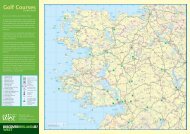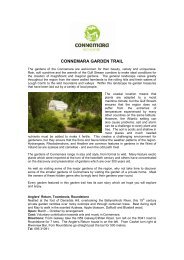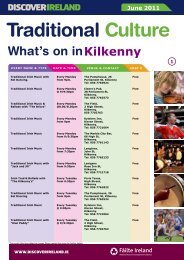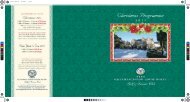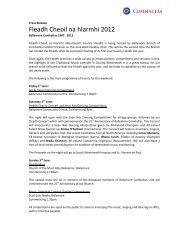Free Guide - Discover Ireland
Free Guide - Discover Ireland
Free Guide - Discover Ireland
You also want an ePaper? Increase the reach of your titles
YUMPU automatically turns print PDFs into web optimized ePapers that Google loves.
Millmount Museum<br />
Millmount Museum and Martello Tower<br />
are situated on high ground in the heart<br />
of Drogheda near to where the river Boyne<br />
finally meets the sea<br />
Shortly after the Anglo-Norman King Henry II granted him the<br />
Kingdom of Meath in 1172, Hugh de Lacy constructed a motte<br />
and bailey on a huge mound overlooking the River Boyne. A<br />
more substantial stone fort replaced the earlier structure.<br />
According to Irish mythology, the mound<br />
was the burial place of Amergin mac Míled,<br />
druid, bard and judge of the Milesians.<br />
Amergin was the son of Míl Espáine and<br />
brother of Éremón (see Myths & Legends,<br />
p. 38). The true origin of the mound is<br />
unclear, however, it is thought that it may<br />
be a large passage tomb, similar to those<br />
at nearby Brú na Bóinne.<br />
This castle formed part of the defences<br />
of the town during Cromwell’s siege of<br />
Drogheda in 1649. The garrison were<br />
massacred when they surrendered to<br />
Parliamentarian troops on September<br />
8 FOR MORE INFORMATION GO TO WWW.DISCOVERIRELAND.IE/BOYNEVALLEY<br />
11th, 1649. In the early 1800s the earlier<br />
fortifications were demolished and<br />
replaced by a Martello Tower as part of a<br />
series of defences erected along the Irish<br />
coast by the British in expectation of an<br />
invasion by Napoleon Bonaparte.<br />
Millmount Museum houses various<br />
exhibitions dealing with archaeology,<br />
folklife, local history, geology, industry and<br />
military history. The museum also contains<br />
one of the four surviving examples of an<br />
ancient type of fishing vessel, called a<br />
coracle, that were once a common sight<br />
on the Boyne. Coracles were made of<br />
wicker and covered with animal hide, or







